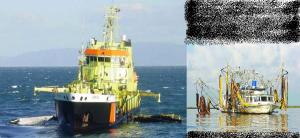Compiled by: Larry Walker, Jr.
Two Dutch companies were on stand-by, on May 4, 2010, to help Americans tackle the oil slick in the Gulf of Mexico. The two companies use huge booms to sweep and suck the oil from the surface of the sea. The U.S. Environmental Protection Agency (EPA), however, has difficulties with the method they use.
So it seems that according to the EPA, it’s acceptable to burn millions of gallons of raw crude, sending the harmful waste into the atmosphere, or to dump millions of gallons of toxic dispersant’s into the waters, but it’s not acceptable to actually collect 75-80% of the oil for recycling?
So has Obama stepped in to waive the Jones Act yet? Not quite, but he did sleep at a Holiday Inn Express on the Gulf Coast. Then, like any good community organizer, he excogitated the extortion of $20 billion from BP.
What do the Dutch have that the Americans don’t when it comes to tackling oil spills at sea?
“Skimmers,” answers Wierd Koops, chairman of the Dutch organization for combating oil spills, Spill Response Group Holland.
The Americans don’t have spill response vessels with skimmers because their environment regulations do not allow it. With the Dutch method seawater is sucked up with the oil by the skimmer. The oil is stored in the tanker and the superfluous water is pumped overboard. But the water does contain some oil residue, and that is too much according to US environment regulations.
US regulations contradictory
Wierd Koops thinks the US approach is nonsense, because otherwise you would have to store the surplus seawater in the tanks as well.
“We say no, you have to get as much oil as possible into the storage tanks and as little water as possible. So we pump the water, which contains drops of oil, back overboard.”
US regulations are contradictory, Mr Koops stresses. Pumping water back into the sea with oil residue is not allowed. But you are allowed to combat the spill with chemicals so that the oil dissolves in the seawater. In both cases, the dissolved oil is naturally broken down quite quickly. It is possible the Americans will opt for the Dutch method as the damage the oil spill could cause to the mud flats and salt marshes along the coast is much worse, warns Wetland expert Hans Revier.
“You have to make sure you clear up the oil at sea. As soon as the oil reaches the mud flats and salt marshes, it is too late. The only thing you can do then is dig it up. But then the solution is worse than the problem.”
Senator convinced
On May 4, 2010, a team of around eight men were on stand-by and four skimmers and extra material were ready to be loaded. The local senator is already convinced and is trying to talk the admiral who is coordinating the operation into accepting help from the Netherlands. The answer may be given today (May 4, 2010).
But nothing is certain. In 1989, a Dutch team and equipment had already been flown in to tackle the Exxon Valdez oil tanker disaster off the coast of Alaska. But in the end the US authorities sent them home.
Source: Radio Netherlands
On day 58, I am just wondering exactly which environment the EPA is trying to protect?

THANK YOU for posting this! Keep up the great work!!
Steve
Common Cents
http://www.commoncts.blogspot.com
ps. Link Exchange???
LikeLike
We don't need help from a bunch of Dutchies.
LikeLike
nice post regarding Oil Spill Skimmer thanks for sharing….
LikeLike